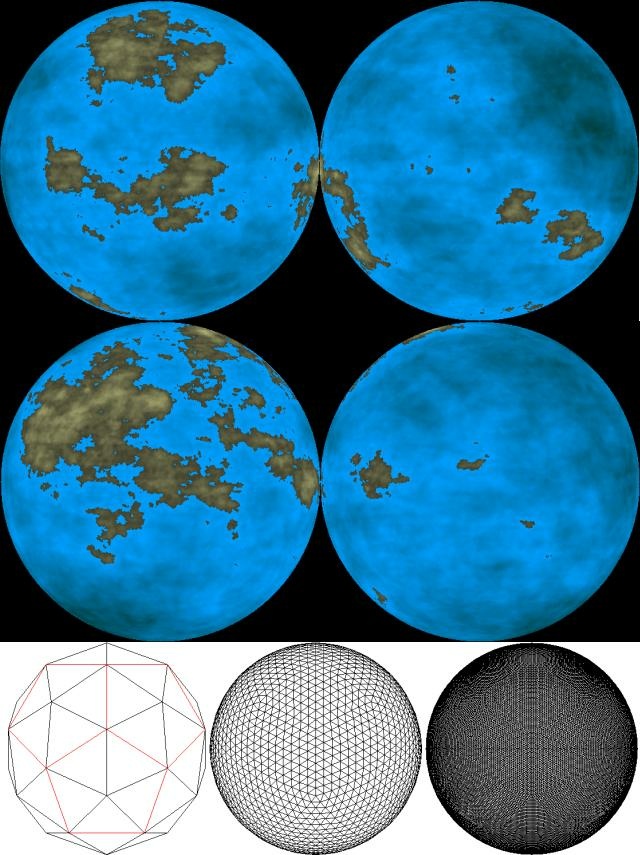 |

Submitted by , posted on 17 December 2001
|
 |

Image Description, by

This is from a terrain generator that I've been working on in the last couple of
weeks. So you may ask what's the big deal? I know there are SEVERAL random
terrain generators out there but the problem with them is that they generally
cannot generate a full-sized planet. They are generally created on a square or
rectangular grid and therefor discontinous at the borders.
So here goes. The way I do it is to generate a sphere from 12 connected
pentagons (like a tetrahedron, but with pentagons instead of triangles). This
gives me 12*5=60 triangles to work with as a basic sphere. You'll see this in
the bottom left picture. I outlined three of the pentagons with red. To increase
the poly count in the sphere, I simply split each of these triangles into four
additional triangles. The middle and left picture contains 3840 and 61440 polys
respectively. This is done blindingly fast and doesn't seem to impact the
generation (which I'll get to just now) much. I store the vertices and the
triangles in two arrays; the triangles as a triangles list with each triangle
having three indices referring to its three vertices PLUS three indices
referring to it's neighbouring triangles (might be important for some reason
like triangle strips or something). Another reason I used 12 pentagons was to
have all of the triangles in the final sphere model almost the same size.
Tetrahedrons as base models normally have a wide size range, especially at high
triangle counts.
The terrain generation is very simple: I form a random plane at a random
distance perpendicular to some random vector eminating from the centre of the
sphere. This distance will of course be between 0 and the radius of the sphere.
Then I go through the vertex list and determine for each vertex whether the
vertex is in front of or behind the plane (simple dot product calculation). The
vertices on the one side of the plane is raised whereas those on the other side
are left as they are. I say here raised but for every vertex I have also
included a height property and this I increase or decrease, I don't actually
alter the spatial coordinate of the vertex (this can be done at a later stage).
Another thing to keep the continents balanced is that every iteration I change
which side of the plane heights are altered, i.e. Iteration 1: front is raised,
iteration 2: back is raised, etc. Otherwise you end up with Himalayas on one
side of your planet and the Abyss on the other.
The two half-spheres in the top of the picture are the results. You can see that
the terrain is continuous all over the surface of the planet. The spheres I used
consisted of 245 760 triangles. I ran the program on a PIII 600MHz machine (no
3D yet) for a 1000 iterations (top) and 2000 iterations (bottom). The first
terrain took about 4.5 minutes and the second 9 minutes. There seems to be a
linear increase in time with an increase in one of the variables (number of
polygons and number of iterations). You'll also see that with increasing number
of iterations some of the sharp "cliffs" are removed. The smoothness of the
terrain will improve with increasing number of iterations.
Possible applications I can think of at the moment would be planet generation
for a planet-wide strategy game or something like that. Anyway, if anybody wants
the code, just mail me. There's still some minor alterations that I'd like to
make and documentation to write. (all code in C++).
Rho
|
|

